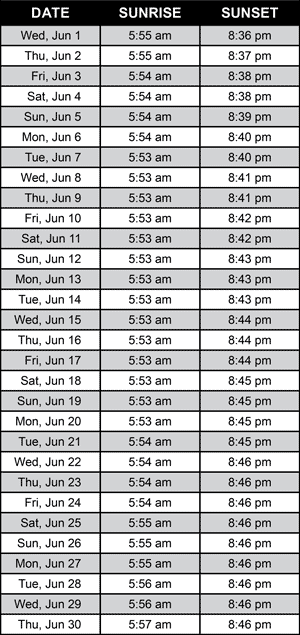DARK SKY HAPPENINGS - June 2022
Moab
UT (at City Hall)
38O34’ N Latitude
109O33’ W Longitude
4048 ft - 1234 m |
Night Lights:
Aurora, Noctilucent Clouds,
and the Zodiacal Light
by David Prosper, NASA Night Sky Notes
Sunrise-Sunset
(The time of sunrise and sunset assumes a flat horizon. Actual time may
vary depending upon the landscape.) |
 |
Aurora are caused when a magnetic storm on our Sun creates a massive explosion that flings a mass of particles away from its surface, known as a Coronal Mass Ejection (CME). If Earth is in the path of this CME, its particles interact with our planet’s magnetic field and result in auroral displays high up in our ionosphere. As we enter our Sun’s active period of its 11-year solar cycle, CMEs become more common and increase the chance for dazzling displays! If you have seen any aurora, you can report your sighting to the Aurorasaurus citizen science program at aurorasaurus.org
Have you ever seen wispy clouds glowing an eclectic blue after sunset, possibly towards your west or northwest? That wasn’t your imagination; those luminescent clouds are noctilucent clouds (also called Polar Mesospheric Clouds (PMC)). They are thought to form when water vapor condenses around ‘seeds’ of dust from vaporized meteorites - along with other sources that include rocket launches and volcanic eruptions - around 50 miles high in the mesosphere. Their glow is caused by the Sun, whose light still shines at that altitude after sunset from the perspective of ground-based observers. NASA’s AIM mission studies these clouds from its orbit high above the North Pole: go.nasa.gov/3uV3Yj1
You may have seen the zodiacal light without even realizing it; there is a reason it’s nicknamed the “false dawn”! Long known to be reflected sunlight from interplanetary dust orbiting in the plane of our solar system, these fine particles were thought to originate from comets and asteroids. However, scientists from NASA’s Juno mission recently published a fascinating study indicating a possible alternative origin: dust from Mars! Read more about their serendipitous discovery at: go.nasa.gov/3Onf3kN
Curious about the latest research into these night lights? Find news of NASA’s latest discoveries at nasa.gov
MOON HAPPENINGS
June 7 - First Quarter at 10:49am
June 14 - Full Moon 7:52am
June 20 - Last Quarter at 11:11pm
June 28 - New Moon at 10:53pm |
Moab Dark Skies mission is to promote the appreciation and conservation of Moab’s valuable and rare dark skies. Moab Dark Skies was established by the Friends of Arches and Canyonlands Parks in conjunction with the National Park Service and Utah State Parks Division of Natural Resources
For more information, check out our Facebook page. |
|